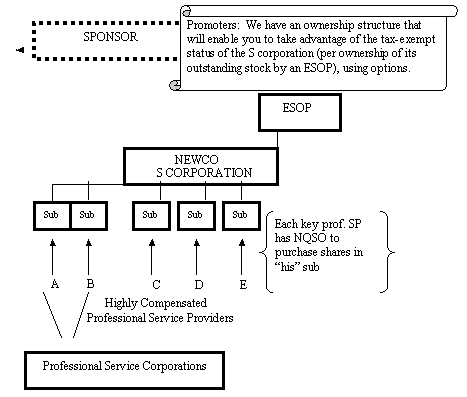LISTED TRANSACTIONS
Listed Transaction #27
(Abusive Use of ESOP/S Corp Ownership)
Abusive Use of ESOP/S Corp. Ownership
Arrangements Aimed at Bypassing Synthetic Equity Rules
IRS Rev. Ruling 2004-4

In this ruling, the IRS attempts to shut down a number of ownership arrangements that attempt to move business profits of the S corporation away from the ESOP (i.e., away from the rank-and-file employees so that they cannot benefit via a meaningful stake in the S corporation). Often, sponsors/promoters attempt to provide the key employee service providers with stock options vis-à-vis stock in qualifying subsidiaries that enable these persons to effectively drain value out of the ESOP for their benefit. In effect, these options amount to synthetic equity forms that enable these persons to retain de facto ownership of their separate businesses.
The ruling notes that if each subsidiary were an S corporation directly owned by an ESOP, an individual’s right to acquire shares of that corporation would be “synthetic equity” per Section 409(p)(6)(C) of the Internal Revenue Code. The structuring of subsidiaries should not enable taxpayers to avoid these requirements.
The ruling states that an abusive use of ESOPs also includes efforts made by a group of individuals holding the same right to acquire the accumulated profits of their businesses, even though each individual technically owns less than 10% of the value of the S corporation by and through each individual’s right to acquire accumulated profits.
In yet another variation, the ruling indicates that a corporation with 200 employees, wholly owned by an ESOP (established after 3/14/01). This corporation drops down a subsidiary “for” the individual who was the prior owner of a professional services corporation. This professional service provider individual terminates employment and that of “his” support staff with the existing corporation to become employees of this subsidiary. He directs customers to begin doing business with the subsidiary. Once in place, the amounts of income generated by business activities can accumulate in the subsidiary, but with the individual service provider maintaining the right to acquire stock in the subsidiary, even though he does not participate in the ESOP.
In each of the situations described in the ruling, the IRS finds that the taxpayer’s right to acquire shares in the subsidiary amounts to synthetic equity and the individual taxpayer a “disqualified person.” As such, a nonallocation year occurs and the anti-abuse rules under Section 409 apply to enable the IRS to challenge the tax benefits claimed by the promoters of these arrangements.
If you believe that you may have engaged in a transaction that is the same or substantially similar to the transaction described above, Federal law may require you to disclose your and other parties’ participation in any such “listed transaction” on IRS Form 8886. For more information about Federal law requirements, please contact us.
